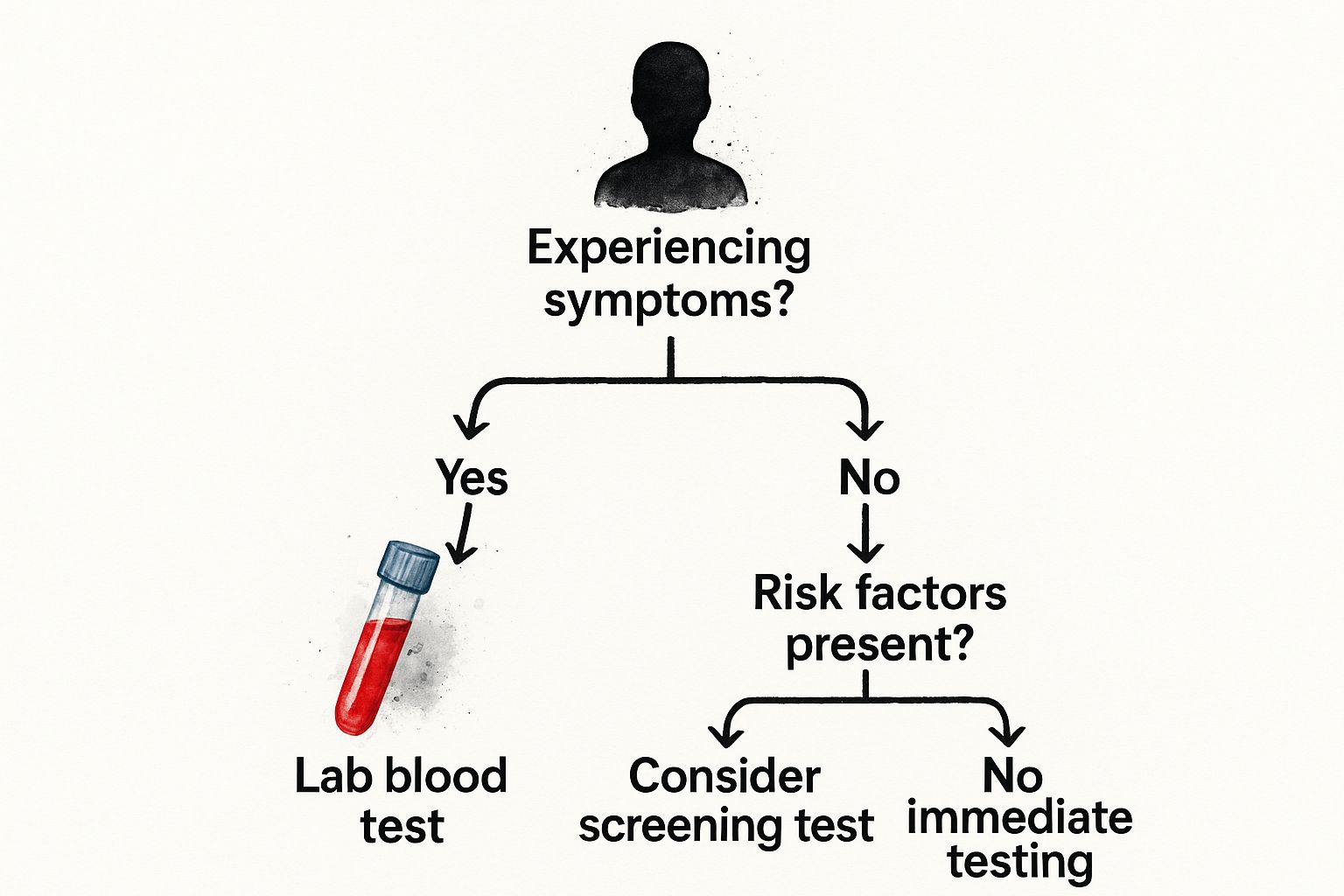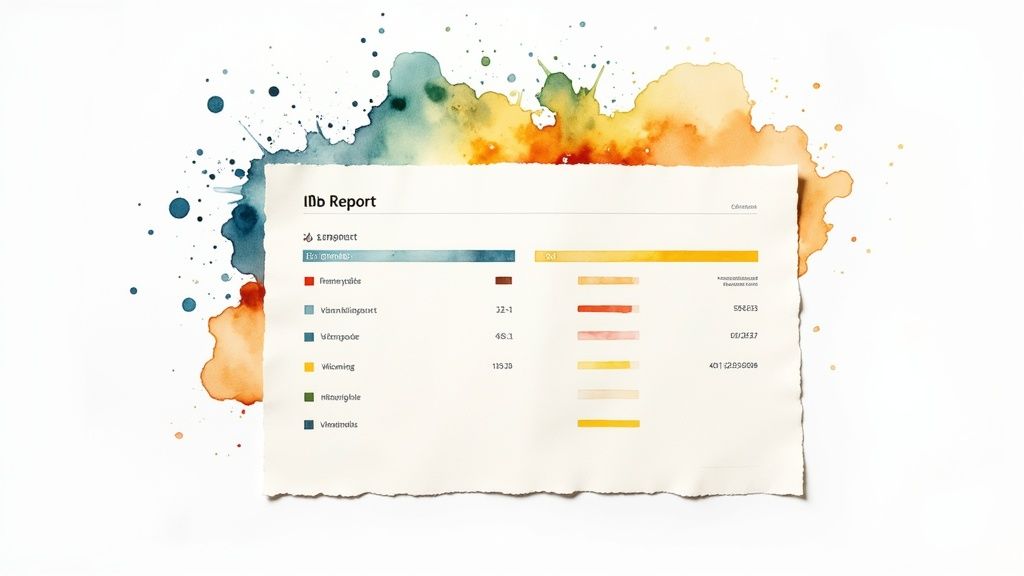Ever feel like you’re running on empty, even after a full night’s sleep? Or maybe you've noticed your hair isn't as healthy as it used to be. These aren't just random annoyances; they're often your body's way of sending out an SOS. The first real step towards optimising your longevity is learning to recognise the subtle clues of a potential vitamin deficiency.
Tuning In: How to Spot the Early Signs of a Deficiency

Before you even think about which test to order, you need to get better at listening to your body. That vague feeling of being "off" is often an early warning system. It’s all too easy to blame a hectic lifestyle, but these feelings can be specific indicators of nutritional gaps that, if left unaddressed, can impact your long-term health and accelerate the ageing process.
Learning to connect the dots between how you feel and what your body might be lacking is a foundational skill for longevity. For instance, persistent fatigue that sleep just can’t seem to fix is a classic red flag for low iron or B12. At the same time, physical changes like thinning hair or pale skin can be surprisingly telling. If you’re concerned about this specifically, our guide on what causes low iron levels is a great place to start.
A Quick Self-Check
Take a moment to check in with yourself. Have you noticed any of these patterns lately?
- Deep-Seated Tiredness: I'm not talking about being a bit tired after a long day. This is a profound exhaustion that lingers, often pointing towards low B12 or iron.
- Mood Swings or Brain Fog: Feeling unusually irritable, down, or forgetful? It’s not always just stress. A shortfall in B vitamins can impair cognitive function over time.
- Catching Everything: If you feel like you're constantly fighting off colds, your Vitamin D levels might be too low to support a strong immune response, a key pillar of healthy ageing.
- Brittle Hair and Nails: These are often outward signs of an internal issue, commonly linked to a lack of biotin or iron.
This quick inventory isn't about diagnosing yourself. It's about gathering personal data. By noticing these patterns, you shift from a general feeling of being unwell to having specific areas you can investigate with targeted testing, forming the basis of a proactive health strategy.
"Paying attention to your body's subtle signals is fundamental to longevity. Catching and correcting nutritional gaps early can stop them from snowballing into more serious, age-related health problems."
It's worth knowing that these deficiencies are more common in the UK than you might think. The latest National Diet and Nutrition Survey found that 23% of children aged 11-18 and 18% of adults aged 19-64 have low Vitamin D levels. It also highlighted that a staggering 83% of women of childbearing age have folate levels below the amount recommended to protect against neural tube defects.
Once you’ve got a clearer picture of your symptoms, you're ready for the next move. Here in the UK, your main options are visiting your GP or using a convenient at-home testing kit. Either way, you're now on the path to taking informed action for your future health.
How to Choose Your Vitamin Deficiency Test
So, you’ve tuned into your body’s signals and think you might have a nutritional gap. What now? The next step is to get some real data. In the UK, you've really got two main paths to get tested: going through your NHS GP or using a private at-home test kit.
Which one you pick really boils down to your primary goal. Are you after convenience and a comprehensive overview for longevity planning, or are you dealing with a very specific, pronounced symptom?
The NHS GP Route
For many, the first port of call is their local doctor. This is a solid choice if you have a clear-cut, major symptom that’s screaming a specific deficiency—think the bone-deep exhaustion that often comes with low B12. Your GP can assess you and order a targeted blood test for that specific nutrient.
The catch? It’s not always the quickest option. Getting an appointment can be a waiting game, and the NHS, understandably, has to manage its resources. This means they’ll typically only test for the one or two vitamins they strongly suspect are low. It’s a reactive approach, great for fixing a specific problem, but less suited for proactive health optimisation and longevity planning.
The Rise of At-Home Testing
If you're looking for a more holistic view to optimise your healthspan, an at-home test kit is a fantastic alternative. These kits let you screen for a whole panel of vitamins and minerals right from your kitchen table. You’re in control.
The convenience factor is huge. There's no need to take time off work or travel to a clinic. You just do a quick finger-prick sample when it suits you, pop it in the post to a lab, and that's it. Within a few days, you get your results digitally, often with clear explanations of what everything means. This empowers you to make smart, immediate changes to your diet and lifestyle to support long-term wellness.
"For optimising long-term health, a broad screening test can uncover hidden insufficiencies before they become symptomatic deficiencies. It's about shifting from reactive problem-solving to proactive health management."
This little chart can help you visualise which path might be right for you from the get-go.

The key takeaway is that you don't have to wait until you feel awful to get tested. If you have known risk factors, it's a brilliant screening tool for longevity.
Comparing Vitamin Deficiency Testing Methods in the UK
Deciding between a GP visit and an at-home kit can feel tricky, so let's break down the key differences to help you choose the best fit for your health goals.
| Factor | NHS GP Visit | Private At-Home Test Kit (e.g., Lola's) |
|---|---|---|
| Primary Use Case | Investigating strong, specific symptoms for a suspected deficiency. | Proactive health screening, longevity planning, and general wellness checks. |
| Scope of Testing | Targeted. Usually tests for only one or two specific nutrients. | Comprehensive. Tests for a wide panel of vitamins and minerals simultaneously. |
| Convenience | Requires booking an appointment and visiting a clinic. | Sample collected at home on your own schedule. No travel needed. |
| Speed of Results | Can take weeks, from getting the appointment to receiving results. | Typically delivered digitally within a few days of the lab receiving the sample. |
| Cost | Free at the point of service (funded by the NHS). | Requires an upfront payment for the test kit and analysis. |
| Actionability | Results may come with a GP follow-up appointment or prescription. | Provides immediate data and insights for lifestyle and diet adjustments. |
Ultimately, both methods have their place. The NHS is an incredible resource for specific medical concerns, while private testing empowers you with broad data for proactive wellness and longevity.
The Shift Towards Proactive Health
We're seeing a massive cultural shift. People are more invested in their health than ever before, and the data proves it. A fascinating study revealed that between 2005 and 2015, requests for vitamin D testing in UK primary care increased more than 50-fold.
This research, which looked at over 210,000 patients, shows just how much public awareness has grown. While this has put pressure on NHS resources, it also signals a powerful desire for data-driven health. You can explore the full study on vitamin D testing trends to see just how significant this movement has become.
Whether you start with your GP or go straight for an at-home kit, the mission is the same: to get the hard data you need to stop guessing and start building a clear plan for your long-term health.
Getting a Good Blood Sample at Home: A Practical Guide

Let's be honest, the thought of pricking your own finger can be a little intimidating at first. But I can tell you from experience that it's a straightforward and incredibly quick process. The real secret isn't about being a medical pro; it's about using a few simple techniques to get a great sample on your first go.
Getting your blood flowing freely before you even open the lancet is the most important part. Trust me, cold hands are the biggest hurdle to a successful collection.
How to Prep for a Hassle-Free Sample
Putting in a few minutes of prep work makes a huge difference. This small bit of effort will dramatically increase your chances of getting a usable sample without any frustration.
- Warm Your Hands: The easiest trick in the book. Just wash your hands under warm water for a minute or two. This helps open up the tiny capillaries in your fingertips, making it much easier to get a good blood drop.
- Get Moving: A quick bit of activity works wonders. Try a few star jumps or just swing your arms by your side for about 30 seconds. This gets your heart rate up and really pushes blood flow to your fingers.
- Hydrate Well: About half an hour before you plan to do the test, drink a full glass of water. Proper hydration makes your blood flow more smoothly.
Once your hands are feeling warm, you’re ready to go. The next step is choosing the right spot. Most people find the side of the ring or middle finger on their non-dominant hand is the sweet spot—it’s less sensitive and usually gives the best blood flow.
For a complete walkthrough, our in-depth guide to at-home blood sampling breaks down every single detail.
Mastering Your Collection Technique
Alright, it's time to collect your sample. The best way to start is by using gravity to your advantage. Stand up and let your arm hang down by your side for a moment; you'll feel the blood start to pool in your fingertips.
When you use the lancet, press it firmly against the side of your fingertip. After the prick, wipe away that first tiny drop of blood with a sterile wipe. This is important because that first drop can contain tissue fluid, which can throw off your results.
Next, gently massage from the base of your finger up towards the tip. This will help a nice, full drop of blood to form.
"A successful at-home test isn't about bravery; it's about technique. Warming your hands and using gravity are the two most effective tips for a stress-free sample collection."
Let each drop fall directly into the collection vial. Try not to scrape your finger along the edge, as this can make the blood clot too quickly or damage the red blood cells. This method is crucial for how we identify and manage vitamin deficiencies here in the UK.
In fact, NHS data shows that adults over 50 account for about 72% of hospital admissions for malnutrition, which often stems from these kinds of nutrient shortfalls. Whether you’re testing at home or in a clinic, getting a good blood sample is the vital first step to optimising your health for the long run.
Understanding What Your Vitamin Test Results Mean
The moment your results land in your inbox can feel like the moment of truth. But let's be honest, a page full of lab values and clinical terms often looks more like a complex puzzle than a straightforward answer. The real skill isn't just seeing the numbers; it's learning to read the story they tell about your long-term health.
This is the point where you shift from simply suspecting a problem to holding concrete data in your hands. A number on a screen transforms into a powerful tool for your healthspan, but only if you know how to translate it into meaningful action.
More Than Just a Number
When you open your report, you'll see your level for each vitamin measured against a set of reference ranges. Getting to grips with these ranges is the first and most important step, because not all "normal" levels are truly optimal for long-term well-being.
Here’s a quick guide to what those categories usually mean:
- Deficient: This is a red flag. Your levels are critically low, and it's highly likely you're already feeling the effects. This requires immediate attention, usually with guidance from a healthcare professional, to get your levels back on track and sidestep potential long-term issues.
- Borderline (or Insufficient): Think of this as an early warning for your future health. You’re not in the danger zone yet, but your levels are far from ideal. You might not have severe symptoms, but your body isn't running on all cylinders, which can quietly chip away at your energy, immunity, and cellular health over time.
- Optimal: This is the sweet spot for longevity. Your levels fall within a range that’s linked to robust health, disease prevention, and feeling your best. Keeping your vitamins in this zone is a fundamental part of any proactive health strategy.
Your test results aren't a final grade; they're a personal roadmap. A 'borderline' result is an opportunity to make small, targeted changes now that can have a significant positive impact on your health decades from now.
A platform like Lola gives you a clear visual dashboard, so you can see at a glance where your levels fall.
This kind of visual breakdown instantly highlights which areas need a bit of work—like the Vitamin D result in the 'Insufficient' range here—so you know exactly what to focus on first.
A Real-World Look at Low Vitamin D
Let's put this into practice. Imagine your report comes back showing a Vitamin D level of 45 nmol/L.
On paper, many labs would classify this as "insufficient" but not severely "deficient." You might not have the classic symptoms of a serious deficiency, like bone pain, but that number is a crucial clue for your long-term health. We know that consistently low-ish Vitamin D levels are linked to a less effective immune system and chronic inflammation—two key drivers of the ageing process.
Understanding this context allows you to be proactive. Instead of shrugging it off, you can take clear steps to improve your levels through sensible sun exposure, dietary changes, or supplementation. If you want to dive deeper into what a healthy range looks like, you can learn more about normal Vitamin D levels in the UK in our detailed guide.
A borderline B12 result is another common one. The symptoms can be frustratingly subtle—maybe a bit of brain fog, or feeling more irritable than usual. Catching this early prevents a slow slide into a more serious deficiency that could eventually impact your nervous system. By spotting the gap, you can make simple tweaks to your diet or consider a B12 supplement, effectively heading off a future health problem before it ever really begins.
Creating Your Personal Longevity Action Plan

Alright, you've got your test results. This is the exciting part—it's where the data meets real life. Think of these results not as a final score, but as the starting block for building a smarter, more sustainable health plan for longevity. We're moving away from guesswork and into targeted action.
A low reading for a specific nutrient isn't a bad mark; it's a clear signpost. It points you directly to an area where a few focused changes can make a massive difference to your long-term health and vitality.
Turning Vitamin D Insights into Action
Let's start with a really common one. Say your results flag insufficient Vitamin D. This is no surprise for most of us in the UK, especially outside of the summer months. Just popping a supplement is one way to tackle it, but for real, lasting benefit, a more rounded approach is far better for long-term health.
A truly effective longevity plan would look something like this:
- Smart Supplementation: Your specific results will guide you to the right daily dose of Vitamin D3. This isn't a random guess; it's a precise amount to get you back on track.
- Strategic Sun Exposure: When the sun does decide to show up, make the most of it. Aiming for just 10-15 minutes of midday sun on your arms and legs a few times a week can kickstart your body's own production.
- Dietary Support: Back this up by weaving more Vitamin D-rich foods into your diet. Think fatty fish like salmon and mackerel, egg yolks, or foods specifically fortified with it.
This combination does more than just fix a number on a report. It creates a robust system that helps your body maintain optimal levels on its own, which is crucial for everything from your immune system to bone health as you age.
"A truly effective action plan is holistic. It pairs the precision of supplementation with the foundational power of diet and lifestyle to create lasting biological change."
These aren't drastic changes. They are small, consistent habits that work together to produce a much bigger impact than any single action ever could.
Optimising Iron Absorption for Lasting Energy
What if your iron levels are borderline? You could just eat more steak or spinach, but if your body isn't absorbing it well, you won't feel the benefit. This is where understanding a bit of nutritional science can be a game-changer for your energy and long-term vitality.
The key is pairing iron-rich foods with Vitamin C, which dramatically improves how much iron your body can actually use.
Here’s how that works in the real world:
| Iron Source | Paired With (for Vitamin C) |
|---|---|
| Spinach or Kale | A squeeze of lemon juice in your salad dressing |
| Lentils or Beans | Bell peppers in a curry or chilli |
| Red Meat | A side of broccoli or tomatoes |
| Iron Supplement | A small glass of fresh orange juice |
See? It’s not about overhauling your entire diet. It’s about making small, clever tweaks that deliver much better results.
Monitoring and Refining Your Approach
Your health plan shouldn't be set in stone. It's a living document that should adapt as your body does. The crucial final step in any longevity strategy is to schedule a re-test.
For most deficiencies you're actively working on, checking your levels again in 3-6 months is a good idea. This follow-up gives you invaluable feedback. It shows you what's working and where you might need to adjust your supplement dose or diet.
This simple cycle of Test > Act > Re-test is the foundation of managing your own health. It ensures your efforts are actually paying off, keeping you firmly on the path to a longer, healthier life.
A Few Common Questions About Vitamin Testing
It's completely normal to have questions when you're looking into health testing. Getting to grips with how to test for a vitamin deficiency is a massive step towards taking charge of your long-term health, so let's clear up a few things you might be wondering about.
How Often Should I Be Testing My Vitamin Levels?
This is a great question, and the answer really depends on your personal situation and longevity goals.
If you’re a healthy adult without any nagging symptoms, getting a proactive test done every one to two years is a smart move. It helps you establish a clear baseline and keep an eye on your health as time goes on, letting you spot any dips before they turn into a real problem.
But sometimes, more frequent checks are a good idea.
- If you're dealing with ongoing symptoms like constant tiredness or brain fog, it's worth re-testing every 3-6 months. This helps you see if the changes you're making are actually moving the needle.
- For those on specific diets, like a vegan diet, for example, more regular testing can make sure you’re not falling short on key nutrients like vitamin B12.
- If you know you have a deficiency and are actively treating it, a follow-up test a few months later is vital. It confirms your supplements are doing their job and your levels are heading in the right direction.
Can I Check for Every Single Vitamin Deficiency with One Test?
In short, no. There isn’t a single magic test that can screen for all 13 essential vitamins in one go. It’s a bit like an MOT for your car – it checks the most important systems to keep you running safely, but it doesn't inspect every last nut and bolt.
Most really good, comprehensive panels—like the ones we've put together at Lola—are designed to screen for the most common deficiencies that have the biggest impact on your healthspan. We're talking about things like Vitamin D, Vitamin B12, folate, and iron. This approach gives you a fantastic, actionable picture of where you stand nutritionally and points you straight to the areas that need a bit of attention.
If your results or symptoms suggest something less common might be going on, that's when you or your doctor can look into more specialised tests.
Think of a broad screening test as getting you the 80/20 of nutritional data. It focuses on the vitamins most likely to affect your energy, immune system, and long-term health, giving you the most valuable insights for your time and money.
Are At-Home Finger-Prick Tests Actually Accurate?
Yes, they absolutely are—as long as you do them properly. The science behind analysing capillary blood from a finger prick is solid and has been trusted for years. For the results to be reliable, it all comes down to two things: how good your sample is and the quality of the lab doing the analysis.
Reputable testing companies use the very same UKAS-accredited labs that the NHS relies on. This means your sample gets processed with the highest level of clinical precision. The part you control is collecting the sample, and that's the most important variable. If you follow the instructions carefully, especially warming your hands up first to get the blood flowing and giving a good-sized sample, you’re ensuring the lab gets a top-quality specimen. And that's what leads to accurate, trustworthy results you can act on.
Ready to stop guessing and start knowing for sure? Take the first step towards feeling your best and optimising your health for longevity with a comprehensive blood test from Lola. We give you clear, actionable insights, delivered right to your inbox. Learn more and order your test today.
